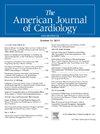Symptoms of Anxiety and Depression in Patients Who Underwent Transcatheter Aortic Valve Implantation: The SAD-TAVI Study
IF 2.3
3区 医学
Q2 CARDIAC & CARDIOVASCULAR SYSTEMS
引用次数: 0
Abstract
Symptoms of anxiety and/or depression (SAD) commonly co-exist in severe aortic stenosis. In patients who underwent transcatheter aortic valve implantation (TAVI), these symptoms are associated with increased morbidity and mortality. Despite this, mental health remains under-researched in the TAVI literature. Drawing from the largest registry in Australia, we aimed to characterize the prevalence of SAD in TAVI patients. We also aimed to identify patient phenotypes at the highest risk of these symptoms, examine how they evolve after TAVI, and establish factors predictive of improvement and regression in mental health. A total of 1,279 patients who underwent TAVI between 2018 and 2023 included in a multi-center Australian registry were analyzed. The median age was 82 years (interquartile range 77 to 87), 41% were females, and the median Society of Thoracic Surgeons score was 3.9 (2.3 to 5.9). In addition, 353 patients (28%) reported moderate or worse SAD at baseline. Of this group, 260 (74%) had complete resolution in symptoms within 30 days. Body mass index <25 kg/m2 (adjusted odds ratio [aOR] 3.4, p <0.001), vascular site complications (aOR 3.4, p = 0.029), and nonhome discharge (aOR 2.4, p = 0.036) independently predicted the persistence of SAD. Only 72 patients (8%) developed new-onset SAD at 30 days after TAVI. Nonhome discharge (aOR 2.12, p = 0.025) and a composite cardiovascular end point, including stroke, acute myocardial infarction, and heart failure readmission (aOR 2.55, p = 0.028), were independent predictors of new-onset SAD. In conclusion, SAD are common but under-recognized in aortic stenosis. TAVI is highly effective at improving these symptoms, and regular screening for mental health should be considered in the management of all TAVI patients.
经导管主动脉瓣植入术患者的焦虑和抑郁症状 - SAD-TAVI 研究。
严重主动脉瓣狭窄(AS)患者通常同时伴有焦虑和/或抑郁(SAD)症状。在接受经导管主动脉瓣植入术(TAVI)的患者中,这些症状与发病率和死亡率的增加有关。尽管如此,经导管主动脉瓣植入术文献中对心理健康的研究仍然不足。我们从澳大利亚最大的登记处收集资料,旨在了解 TAVI 患者中 SAD 的发病率。我们还旨在确定出现这些症状风险最高的患者表型,研究这些症状在 TAVI 术后如何演变,并确定预测心理健康改善和退步的因素。我们对澳大利亚多中心登记处纳入的 2018 年至 2023 年期间接受 TAVI 的 1279 名患者进行了分析。中位年龄为82岁(IQR为77岁至87岁),41%为女性,中位STS评分为3.9分(2.3分至5.9分)。353名(28%)患者在基线时报告了中度或更严重的 SAD。其中 260 人(74%)在 30 天内症状完全缓解。体重指数
本文章由计算机程序翻译,如有差异,请以英文原文为准。
求助全文
约1分钟内获得全文
求助全文
来源期刊

American Journal of Cardiology
医学-心血管系统
CiteScore
4.00
自引率
3.60%
发文量
698
审稿时长
33 days
期刊介绍:
Published 24 times a year, The American Journal of Cardiology® is an independent journal designed for cardiovascular disease specialists and internists with a subspecialty in cardiology throughout the world. AJC is an independent, scientific, peer-reviewed journal of original articles that focus on the practical, clinical approach to the diagnosis and treatment of cardiovascular disease. AJC has one of the fastest acceptance to publication times in Cardiology. Features report on systemic hypertension, methodology, drugs, pacing, arrhythmia, preventive cardiology, congestive heart failure, valvular heart disease, congenital heart disease, and cardiomyopathy. Also included are editorials, readers'' comments, and symposia.
 求助内容:
求助内容: 应助结果提醒方式:
应助结果提醒方式:


